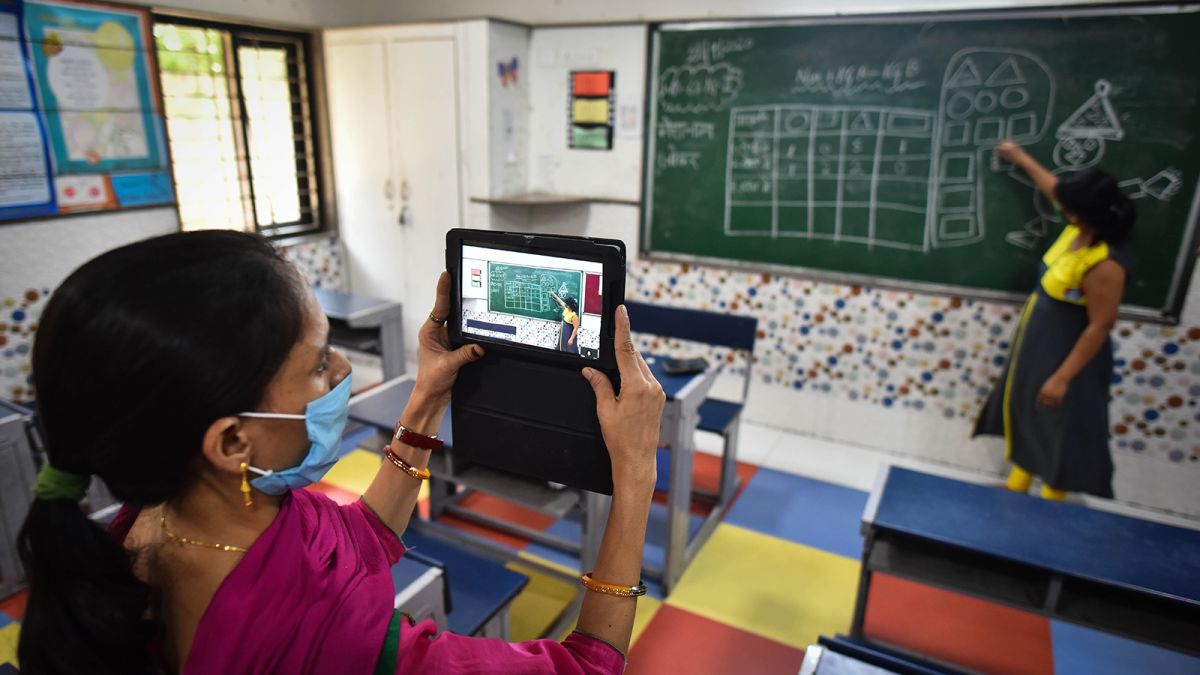In the wake of the COVID-19 pandemic which had incapacitated the entire globe towards the end of March 2020, educational institutions shut down as governments across the globe imposed nation-wide lockdowns. According to a UNESCO report, between March and April, close to 165 nations shut down schools and colleges, affecting nearly 90% of the student population in the world. Even now, 29 countries have still imposed full closure while 74% of the learning population is in regions where educational institutions are still partially closed.
As far as India is concerned, more than 32 crores of students have been affected by the various restrictions, with primary and secondary students being the most heavily affected. To ensure that students do not lose out on education and time, most schools and colleges have gone online, ever since. While the plight of students and the struggles of attending online classes, especially for those from the underprivileged classes has received due attention, issues faced by the teachers seem to have gone largely unnoticed.
Online classes and the teachers’ affliction
With the introduction of a national policy on Information and Communication Technology in schools in 2012, integration of technology in the curriculum did become a part of the teaching process. However, the changes, largely limited to the use of multimedia tools, were nothing compared to the scale at which the pandemic necessitated technological literacy on part of the teachers. From video conferencing apps like Zoom and Google Meet, to more nuanced and customised platforms like Microsoft Teams, teachers barely had time to get acquainted with technology that was completely new to them.
To fully understand their experience, teachers from different states across the country, specialising in different subjects and teaching different grades were interviewed. “Getting used to the new technology and having to prepare hours in advance for classes was very difficult to juggle along with the extra burden of household chores,” said one of them.
Also read: Understanding How The COVID-19 Crisis Impacted Girls’ Education In India
Institutional shortcomings
Lack of adequate training and resources increased the difficulties severalfold. Most teachers found both the quality and quantity of training and resources provided to be inadequate. They felt that it failed to equip them with the skills and confidence required to conduct online classes with minimum hitches. For many, the so-called training was limited to YouTube tutorials and half-hearted follow-ups aimed at addressing doubts or apprehensions.
This experience, though quite common, cannot be generalised as there were a few exceptions who felt that the training provided was sufficient to help them make a comfortable transition. A primary school teacher in Kolkata reported that she had to repeatedly ask her children to help her with basic technological requirements, such as scanning and uploading worksheets. Co-operation from family members, especially the younger generation, is an important factor when learning new technology. In fact, a significant majority of the teachers unanimously attribute eventual comfort with and fewer obstacles during online classes to the help provided by the younger generation at home who are much quicker at adapting to new technology, having grown up surrounded by it.
Gendered nature of the problem
Getting used to unfamiliar technology is never an easy task for most people; but to do so in the middle of a global lockdown with the added baggage of increased responsibilities at home and anxiety surrounding health and safety at an all-time high must have been enough to make the transition harder.
With everyone being locked in and without domestic help, female teachers faced an even bigger challenge as household is primarily considered a woman’s responsibility, working or otherwise. The number of women in the primary and secondary education sectors being approximately four and six million respectively, a significant percentage of the teaching population is doubly burdened due to the gendered distribution of household chores.
Research documents that in our education system, women are often disadvantaged in their ability to learn about and profit from information technology. A report by Evidence of Policy Design at Harvard Kennedy School in 2018 states that 67% percent of men in India own mobile phones, while only 33% of the women do. The study believes that traditional gender norms and economic barriers form the roots of gendered access to devices.
According to a report on the Internet gender gap in India, the two main mental barriers to women’s access to the internet were discomfort with technology and lack of interest. Other psychosocial barriers were women’s perception that using the internet was inappropriate, and disapproval from friends and family members. In the same study, respondents stated that due to a lack of technical skills, they often had to take assistance from others to operate electronic devices. The gap in digital literacy became visible during the shift from traditional modes of teaching to the use of educational technology.
Also read: COVID-19: Why Is Social-Emotional Learning Important For Children
Inefficient Pedagogy – Struggles of Using EdTech in India
The shift to online education has majorly impacted and altered approaches to teaching. Quality learning, seen in classrooms in the form of interaction with educators and batch mates, body language, monitoring of students, and sharing of live examples, is compromised in an online classroom. A sizable percentage of teachers had little to negligible experience with using technology.
With online classes, the requirements go beyond the normal to include having to work with Google sheets for data collection, sharing screens, making, and editing videos and adapting the curriculum to suit online teaching. There is a constant need to be digitally competent to keep the students engaged. For those teaching Indian languages like Hindi or Marathi, the unavailability of sufficient books at a home-setting, no access to libraries and lack of facilities like whiteboards made it more difficult.
In a research study conducted on the impact of the coronavirus pandemic in the Indian education sector, respondents stated that their confidence and efficiency reduced as they were not able to express themselves in an influential way. Evaluating online assessments and examinations was equally burdening, as there were chances of error when trying to input data from hand-written documents to the software.
“Sending links on the WhatsApp groups, having to answer parents’ doubts related to the new tech that I myself wasn’t familiar with, making and editing videos for various topics that couldn’t be covered in online class was extremely stressful in the beginning,” said one of the respondents.
Exposure to Privacy Risks and Bullying
A major challenge to this digital shift is also the constant bullying teachers are exposed to. Use of offensive terms addressing teachers on the chat-box, kicking them out of the meeting, displaying explicit content, and disregarding confidentiality are common instances of cyberbullying. The process of learning technology is hampered amidst harassment by the students. Emotional violence as an attempt to assert dominance over teachers directly impacts the educators’ mental and emotional well-being.
Female educators and facilitators are also often at a risk of compromising their privacy when imparting knowledge to a diverse audience, through online webinars, workshops, etc. In the study by Harvard Kennedy School, Indian women stated that they don’t use technology as they feared exposure to unwanted content and comments.
Possible solutions and a way forward
Technology in higher education has become a more integrated and important part of the teaching and learning process over the years. The challenges to education posed by the pandemic and the many roadblocks faced throughout have only highlighted the direness of the need for embracing technology. Access and familiarity with advanced technology is expected from both students as well as the teachers. To begin with, educational institutions operating at all levels must include more comprehensive technological training for their teaching staff, going beyond the simple use of multimedia tools.
While it can be said that the extent to which teaching became dependent on newer forms of technology during the pandemic could not have been predicted, a common complaint voiced by most teachers regarding alienness of it all points to a systemic issue in our approach to technology. Training should be accompanied with sufficient exposure and regular use of technology in daily practice. This would help to mitigate the fear and unfamiliarity of technology, ensuring that should a need arise in the future, the process of adapting to new technology would be faster and accompanied by lesser stress.
Also read: Video: Lockdown and Education – Is India Ready For Online Classes For All
Thus, equipping educators, especially female educators, with better and frequent access to digital modes of learning complemented with encouraging higher engagement with requisite devices to those who can afford them and aiding access to those who lack the purchasing power can go a long way in improving digital literacy amongst teachers, paving the way forward for higher and easier integration of technology with education.
Finally, as a step towards bridging the gender gap in the use of technology and the internet. A safer cyberspace and classroom environment must be enforced to assuage any privacy breach or harassment related apprehensions that female teachers might hold.
Tarika Shekdar (She/Her) is an Organisational Psychology and HRM Trainee at Nolmë Labs, an academic research and science communication organisation. Tarika is an avid reader and travel enthusiast who loves to ponder over the inner workings of the human mind in her free time. She tweets at @tarika_01.
Sharanya Mosalakanti is an Organisational Psychology & HRM Trainee at Nolmë Labs, an academic research and science communication organisation. She is passionate about singing and enjoys exploring new genres of music. She has been involved in community service since childhood, and wishes to pursue a career in Organisational Psychology. She tweets at @sharanyaxm.
Featured Image Source: A teacher records her colleague conducting an online class during the coronavirus pandemic, September 22, 2020 via CNN




